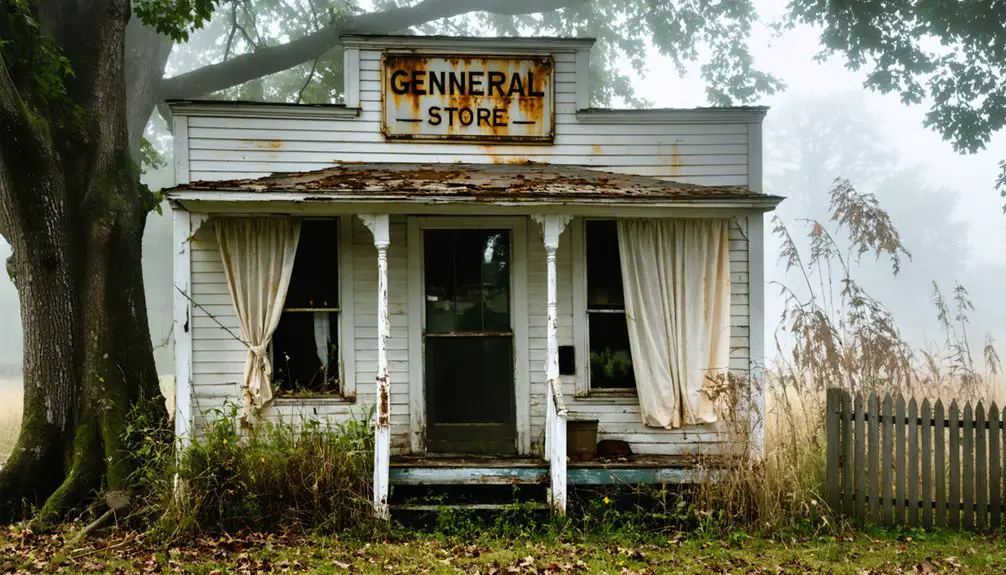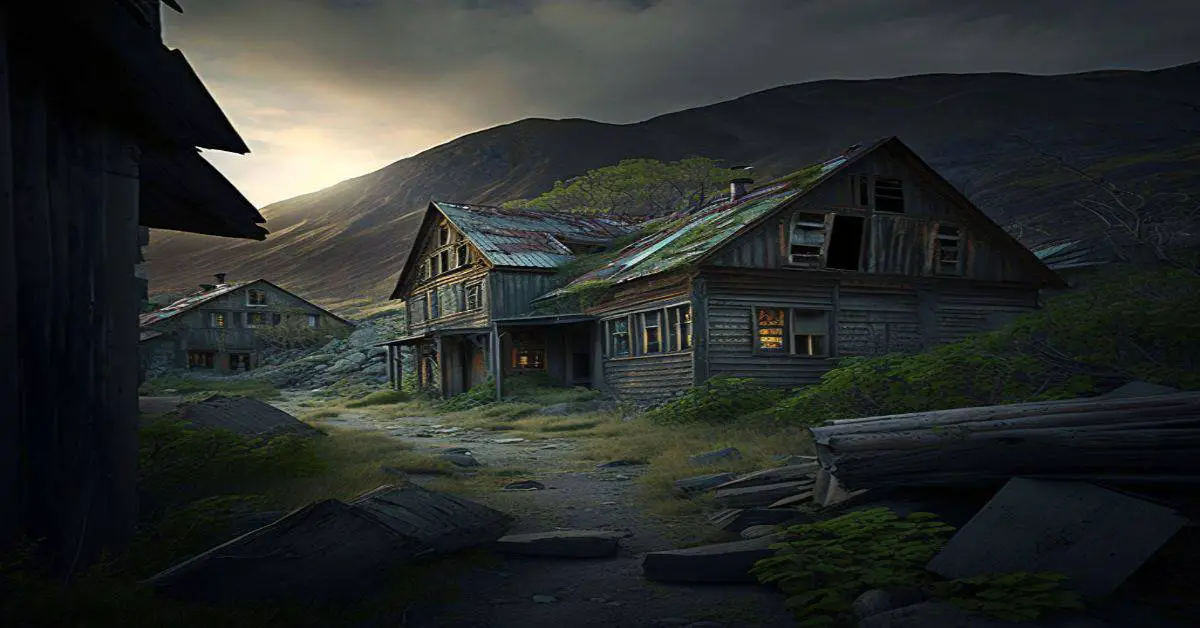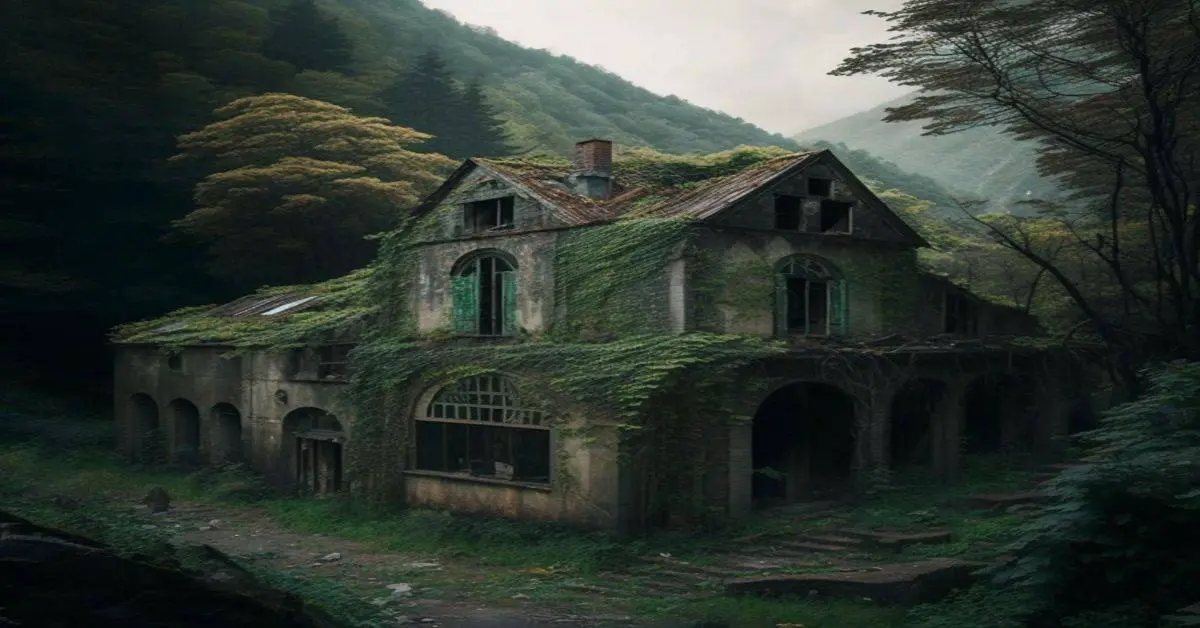You’ll find Meredith, Michigan’s most notorious lumber town, as a haunting reminder of the 1880s timber boom. Founded in 1883, it quickly grew to 1,800 residents with a bustling business district, three-story school, and numerous saloons known for violent brawls. By 1896, timber depletion and a devastating forest fire reduced this once-thriving community to ruins. Today, roughly 300 residents and an abandoned cemetery tell a fascinating story of frontier life and swift decline.
Key Takeaways
- Meredith transformed from a bustling lumber town of 1,800 residents in the 1880s to a ghost town by 1900 due to timber depletion.
- A devastating forest fire in 1896 destroyed remaining structures, accelerating the town’s abandonment after its economic collapse.
- The removal of railroad tracks, closure of the post office, and dismantling of infrastructure marked the town’s transition to ghost town status.
- Today, Meredith exists as an unincorporated community with approximately 300 residents and minimal remaining historical structures.
- An abandoned cemetery and former drive-in theater site serve as the main physical reminders of Meredith’s once-thriving past.
The Birth of a Lumber Town (1883-1884)
Three pivotal events marked Meredith’s establishment in 1883: the arrival of thousands of lumberjacks, the construction of essential infrastructure, and the town’s rapid emergence as a lumber industry hub in northeastern Clare County, Michigan.
You’d have witnessed remarkable community growth as lumber camps sprouted up around the settlement, transforming it into what local newspapers dubbed “a wonder of the north woods” and “the great city of the day” by 1884.
The town quickly developed core services catering to lumbermen, including food and clothing stores, multiple saloons, hotels, and a crucial railroad depot. The community soon reached its peak with a booming population of 1,800 during the late nineteenth century.
Frontier commerce flourished in Meredith, as businesses sprang up to serve the needs of the hardworking lumbermen.
The impressive Corrigan House hotel, stretching 40 feet by 105 feet across three stories, stood as a testament to the town’s early prosperity.
While Meredith lacked certain institutional pillars like a church or funded sheriff’s office, it nonetheless established itself as a bustling frontier settlement within its first year.
Wild Days: The Toughest Town in Michigan
If you’d visited Meredith between 1883 and 1900, you’d have encountered Michigan’s most notorious lumber town, where saloon brawls and violence shaped daily life among its 1,800 residents.
The town’s reputation for lawlessness grew as fights frequently turned deadly, with church-going locals refusing cemetery burials to those who died under violent or drunken circumstances.
You’d have witnessed a stark divide between the rough-and-tumble lumberjacks who frequented the town’s numerous saloons and the civic-minded residents who attempted to maintain order despite the absence of formal law enforcement.
A shocking example of the town’s violence occurred when resident Rosa Smith turned a weapon on Benjamin Villeneuve, leaving him with three missing teeth.
The infamous Sin City, USA nickname emerged from the steady stream of murders, gunfights, and barroom brawls that dominated the town’s daily affairs.
Saloon Brawls and Bloodshed
During the lumber boom years of 1883-1900, Meredith earned its notorious reputation as “The Toughest Town in Michigan” through the bloody violence that erupted daily in its numerous saloons.
With a population of 1,800 at its peak, the town’s saloon culture thrived as rough lumbermen crowded these establishments, leading to violent confrontations that often turned deadly. Similar to how Detroit’s population declined drastically over the decades, Meredith’s residents gradually abandoned the once-bustling town. Like many other ghost towns documented by Roy L. Dodge, Meredith’s history faded into Michigan’s past.
You’d have witnessed fistfights breaking out daily, while gunfights weren’t uncommon. In 1894, Rosa Smith shot Benjamin Villeneuve in the mouth at a Main Street dance house, just one example of the brutal encounters that defined the era.
The violence was so pervasive that many slain lumbermen couldn’t even be buried in the local cemetery, as church-going residents rejected their remains, forcing alternative burial arrangements.
Lawless Lumber Camp Life
Behind Meredith’s violent saloon culture lay an even more untamed world: the remote lumber camps that bred the town’s notorious reputation.
You’d find yourself among a diverse brotherhood of lumberjacks from Michigan, Maine, and Nordic countries, sharing cramped bunkhouses deep in the wilderness. Despite the tough physical demands of timber work, these camps fostered a unique lumberjack camaraderie born from isolation and shared hardship. Lumberjacks relied on spring rains to transport their freshly cut logs downstream to the sawmills. Six-day workweeks with grueling dawn-to-dusk shifts defined the relentless pace of camp life.
Daily life presented constant timber industry challenges, from wrestling massive logs with primitive tools to dodging deadly accidents.
Without law enforcement’s watchful eye, camps became breeding grounds for vice and lawlessness. Your neighbors might include hardened criminals like Jim Carr or desperate men seeking escape from civilization.
The camps’ legacy of environmental destruction and moral decay eventually led to Meredith’s downfall, leaving only ghost town remnants of this untamed era.
Violence Shapes Town Legacy
While lumber camps fostered lawlessness in Meredith’s outskirts, the town itself earned its reputation as “The Toughest Town in Michigan” between 1883 and 1900. Daily barroom fights, murders, and vice took their toll on the community’s social fabric. You’d find neither a functioning sheriff nor a church, as violence discouraged basic civic institutions from taking root.
The violent legacy touched every aspect of town life. Church-going residents refused to bury slain lumberjacks in the local cemetery, creating bitter divisions. Much like The Lodge’s early days of opening during COVID, the town faced significant challenges establishing itself amid difficult circumstances. Notorious criminals like Jim Carr and Maggie Duncan flourished in this lawless atmosphere, while corrupt judges and reluctant witnesses hampered justice.
When lumber resources dried up, this brutal reputation hastened Meredith’s decline. The community impact of unchecked violence ultimately made permanent settlement unsustainable, transforming a once-prosperous town into a ghost of its former self.
Economic Peak and Infrastructure Development
During Meredith’s heyday in the late 1800s, you’d find a bustling business district catering to the town’s 1,800 residents and numerous lumbermen, complete with three hotels, multiple saloons, and an opera house.
The town’s strategic position near crucial lumber resources was enhanced by its railroad infrastructure, including a depot and roundhouse that facilitated timber transport and commerce. Like Old Rawsonville Village, the town’s fortunes were deeply tied to the lack of railroad service which proved crucial for economic sustainability.
You can imagine the economic vitality of this era through the substantial three-story school building and city hall, which reflected the community’s peak investment in municipal facilities.
Thriving Business District
At the height of its prosperity in the late 1800s, Meredith transformed into a bustling commercial hub with a population of 1,800 residents.
You’d find a diverse business district that reflected the town’s rapid growth and dynamic community spirit. The streets buzzed with activity as lumbermen and travelers moved between establishments that served their daily needs.
- Three hotels catered to visitors and temporary workers, supporting the town’s mobile workforce.
- Multiple saloons earned Meredith the nickname “The Toughest Town in Michigan.”
- An opera house provided cultural entertainment, elevating the town’s social offerings.
- Essential services included a post office, serving the community from 1884 to 1895.
The business growth fostered vibrant community dynamics, with commercial establishments clustered around the train depot, creating a self-sustaining economic ecosystem.
Railroad and Lumber Operations
The backbone of Meredith’s economic success lay in its strategic railroad infrastructure, anchored by the Pere Marquette (PM) railroad line.
You’d find narrow gauge railways branching out from the mainline, connecting remote timber stands to the bustling hub. As logging technology advanced from horse-drawn sleds to steam jammers, Meredith’s production soared to incredible heights.
Railroad expansion transformed timber transport, freeing operations from seasonal constraints. The PM and private logging railroads moved billions of board feet during peak production in the 1870s and 1880s.
You could spot massive crews of up to 3,000 men working the winter camps, while year-round rail operations kept lumber flowing to Great Lakes ports. This robust network positioned Meredith as the crucial link between northern Michigan’s rich forests and broader markets.
Daily Life in a Rugged Frontier Community
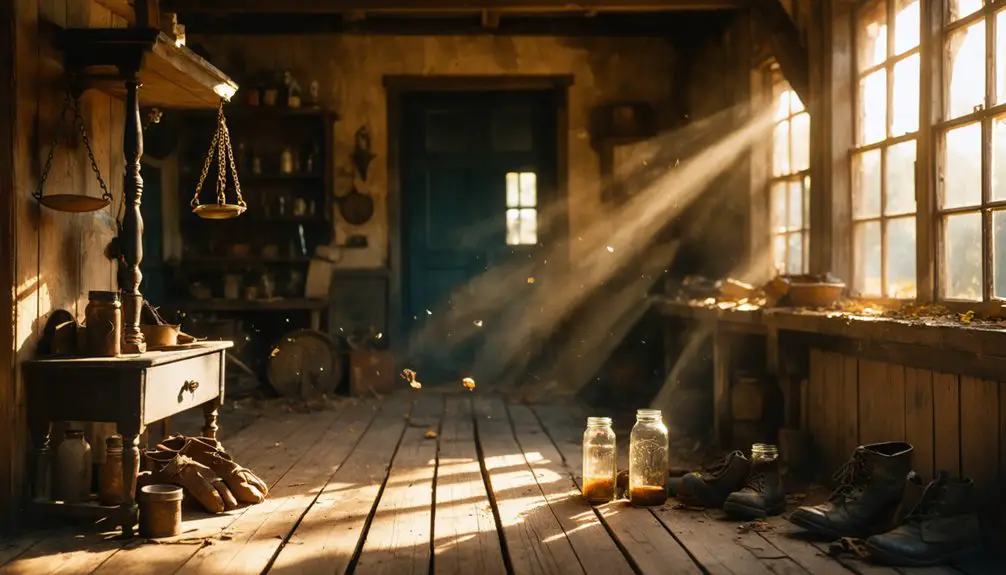
Life in Meredith centered around the demanding lumber industry, where most men worked dangerous jobs as lumberjacks or in sawmills while merchants supplied the essentials needed to keep the rough-and-tumble town functioning.
Your daily routines would’ve revolved around basic survival in this frontier setting, where community challenges included minimal amenities and frequent violence.
- You’d find yourself living in simple, hastily built housing near the lumber camps.
- Your entertainment options centered on the opera house or one of the town’s many saloons.
- You’d send your children to the impressive three-story school, a rare frontier luxury.
- Your safety would depend on sporadic law enforcement in a town known for brawls and gunfights.
The lack of permanent infrastructure and health services made everyday life particularly demanding, reflecting the transient nature of this logging community.
The Swift Decline of Meredith (1890-1900)
While Meredith’s rugged frontier spirit once epitomized Michigan’s lumber boom, dramatic changes swept through this bustling community between 1890-1900.
You’d hardly recognize the town after timber depletion stripped away its economic foundation. By 1893, the valuable lumber was gone, forcing workers to abandon their jobs and seek opportunities elsewhere. The devastating ripple effects led to widespread business closures – from bustling saloons to prosperous hotels.
The economic collapse accelerated rapidly. You’d see the physical dismantling of the town as railroad tracks were torn up and the depot removed.
When the post office closed in 1895, it marked the end of essential services. A catastrophic forest fire in 1896 dealt the final blow, destroying what little remained of this once-thriving lumber town.
Lost Buildings and Relocated Heritage
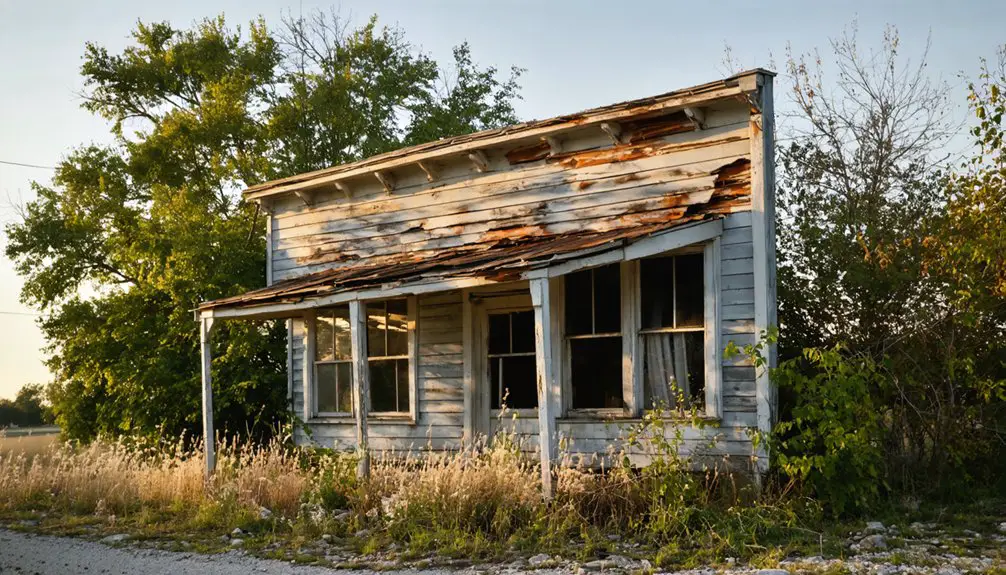
Once bustling with frontier commerce, Meredith’s architectural heritage now exists largely in relocated fragments and fading memories.
You’ll find precious few original structures standing in their intended locations, as fires and economic decline stripped away most lost structures from the landscape.
The heritage relocation story of Meredith reveals how buildings adapted to survive:
- The opera house found new life as a church after being moved south to Arthur Township
- The Meredith General Store stands reconstructed at its original site, marking where the railroad depot once thrived
- Salvaged bricks and stones from destroyed buildings live on in surrounding communities’ structures
- The abandoned drive-in theater remains as one of the few visible landmarks, guarding a hidden cemetery beneath encroaching vegetation
Modern Remnants and Current Population
Although Meredith’s population has dwindled to roughly 300 residents from its historical peak of 1,800, this unincorporated community still maintains a quiet but active presence.
Despite its decline from 1,800 to 300 residents, Meredith maintains its resilient spirit as a small but enduring rural community.
You’ll find population trends reflecting broader rural Michigan patterns, with most current inhabitants living in residential areas served by just a few local stores.
While commercial viability isn’t what it once was during the lumber boom, the community persists with minimal infrastructure. The old drive-in theater site along Meredith Grade Road remains a notable landmark, though it’s been inactive since the mid-1980s.
The abandoned cemetery, now on private property, serves as one of the few tangible links to the town’s past. Despite its ghost town classification, Meredith continues to attract both residents and curious visitors.
The Forgotten Cemetery
The forgotten Meredith Cemetery lies hidden behind private fencing off Meredith Grade Road, marking a somber chapter in the town’s lumber era history.
You’ll find “Keep Out” signs protecting what remains of this cemetery where hidden histories tell the tales of those society once shunned.
- Only one or two visible graves remain among the overgrown woods, their markers eroded by time.
- The site once served as final rest for the town’s “no goods,” who paid $200 to Tom Garrity for burial rights.
- Friends would sometimes honor their departed with barroom songs during informal funerals.
- Unlike other ghost town cemeteries that welcome visitors, Meredith’s forgotten stories stay locked behind private gates.
These forgotten stories reflect the harsh social divisions that persisted even after death in Michigan’s lumber era.
Legacy in Michigan’s Timber History
Beyond the forgotten cemetery‘s gates lies a broader story of Meredith’s impact on Michigan’s timber industry.
You’ll find in Meredith’s history a stark example of how the lumber boom transformed Michigan’s landscape between 1883 and 1900. The town’s rapid rise and fall mirrors countless other settlements that sprung up across the state’s northern counties during this era.
As timber scarcity set in, Meredith’s transformation into a ghost town became inevitable.
What’s remarkable is how completely the town served the timber industry’s needs – from its railway roundhouse to its infamous saloons where lumberjacks spent their wages.
Today, you can understand Michigan’s broader lumber history through Meredith’s story, where the pursuit of timber wealth created a wild, lawless frontier that vanished as quickly as it appeared.
Frequently Asked Questions
Were There Any Major Crimes or Murders Reported During Meredith’s Peak Years?
You’ll find historical records mention murders, arson, and human trafficking by criminals like Jim Carr and Maggie Duncan, though specific crime statistics weren’t well documented during those lawless peak years.
What Happened to the Families Who Stayed After the Lumber Industry Collapsed?
You’ll find those remaining families turned to subsistence farming, seasonal work, and small trades for survival, while maintaining tight-knit community bonds despite reduced services and economic hardships they faced.
Did Native Americans Have Any Settlements or Interactions in the Meredith Area?
While your ancestors built homes on open land, Native settlements of Potawatomi, Ojibwe, and Odawa tribes thrived there first, with cultural interactions marking early relationships between settlers and indigenous peoples near Meredith.
What Were the Average Wages and Living Costs in Meredith’s Lumber Era?
You’d earn $20-26 monthly as a lumberjack with free room and board, while sawmill workers made $30-50 but paid living expenses. River drivers earned higher wages due to risk.
Were There Any Notable Epidemics or Medical Crises in Meredith?
Peculiarly pristine records show you won’t find documented epidemic outbreaks in the town’s history. Despite rough frontier conditions and limited medical treatments, there’s no evidence of major health crises affecting the community.
References
- https://99wfmk.com/toughest-town-in-michigan/
- https://northernmichiganhistory.com/pere-cheney-michigans-legendary-ghost-town/
- https://www.geocaching.com/geocache/GC1T45Q
- https://bluelemon.me/2013/04/26/meredith-wonder-of-the-north-woods-back-in-1884-anyway/
- https://bluelemon.me/tag/meredith-michigan/
- http://www.historygrandrapids.org/article/2137/the-great-log-jam-of-1883
- https://clarecountyhistory.org/wp-content/uploads/2024/09/WHITE-NOTEBOOKS_only.pdf
- https://www.michigan.gov/libraryofmichigan/public/michigan/bibs/lumbering-in-michigans-history
- https://voyagemichigan.com/interview/check-out-meredith-sherrods-story/
- https://www.youtube.com/watch?v=t7gd_7BuExM
